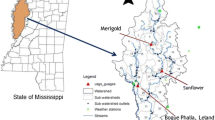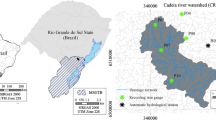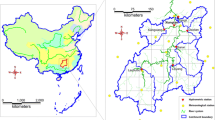Abstract
An efficient calibration with remotely sensed (RS) data is important for accurate predictions at ungauged catchments. This study investigates the advantages of streamflow-sensitive regionalization on calibration with RS evapotranspiration (ET). Regionalization experiments are performed at 28 catchments in Australia. The catchments are classified into three groups based on annual rainfall and runoff coefficients. Streamflow, RS ET, and a multi-objective RS ET-streamflow calibration are performed using the DiffeRential Evolution Adaptive Metropolis algorithm in each catchment. Simplified Australian Water Resource Assessment-Landscape model is calibrated for a selection of five parameters. Posterior probability distributions of parameters from three calibrations performed at donor catchments in each group are inspected to find the parameter for regionalization in the individual group. In group 1 of wetter catchments, regionalization of parameter FsoilEmax (soil evaporation scaling factor) helps to simplify the calibration without any deterioration in ET, soil moisture (SM) and streamflow predictions. Regionalization of parameter Beta (coefficient describing rate of hydraulic conductivity increase with water content) in group 2 assists to improve the streamflow predictions with no decrement in ET and SM predictions. However, regionalization is not able to provide satisfactory results in group 3. Group 3 includes low-yielding catchments, with average annual rainfall below 1000 mm/year and runoff coefficient less than 0.1, where traditional streamflow calibration also fails to produce accurate results. This study concludes that streamflow-sensitive regionalization is effective for improving the efficacy of RS ET calibration in wetter catchments.










Similar content being viewed by others
References
Abdulla FA, Lettenmaier DP (1997) Development of regional parameter estimation equations for a macroscale hydrologic model. J Hydrol 197(1–4):230–257
Alvarez-Garreton C, Ryu D, Western AW, Crow WT, Robertson DE (2014) The impacts of assimilating satellite soil moisture into a rainfall–runoff model in a semi-arid catchment. J Hydrol. https://doi.org/10.1016/j.jhydrol.2014.07.041
Alvarez-Garreton C, Ryu D, Western AW, Su CH, Crow WT, Robertson DE, Leahy C (2015) Improving operational flood ensemble prediction by the assimilation of satellite soil moisture: comparison between lumped and semi-distributed schemes. Hydrol Earth Syst Sci 19(4):1659–1676. https://doi.org/10.5194/hess-19-1659-2015
Andersen J, Dybkjaer G, Jensen KH, Refsgaard JC, Rasmussen K (2002) Use of remotely sensed precipitation and leaf area index in a distributed hydrological model. J Hydrol 264(1–4):34–50. https://doi.org/10.1016/S0022-1694(02)00046-X
Asner GP, Scurlock JM, Hicke JA (2003) Global synthesis of leaf area index observations: implications for ecological and remote sensing studies. Glob Ecol Biogeogr 12(3):191–205
Athira P, Sudheer KP, Cibin R, Chaubey I (2016) Predictions in ungauged basins: an approach for regionalization of hydrological models considering the probability distribution of model parameters. Stoch Env Res Risk Assess 30(4):1131–1149. https://doi.org/10.1007/s00477-015-1190-6
Barrett DJ, Renzullo LJ (2009) On the efficacy of combining thermal and microwave satellite data as observational constraints for root-zone soil moisture estimation. J Hydrometeorol 10(5):1109–1127
Bartalis Z, Wagner W, Naeimi V, Hasenauer S, Scipal K, Bonekamp H, Figa J, Anderson C (2007) Initial soil moisture retrievals from the METOP‐A Advanced Scatterometer (ASCAT). Geophys Res Lett 34 (20)
Boegh E, Thorsen M, Butts MB, Hansen S, Christiansen JS, Abrahamsen P, Hasager CB, Jensen NO, van der Keur P, Refsgaard JC, Schelde K, Soegaard H, Thomsen A (2004) Incorporating remote sensing data in physically based distributed agro-hydrological modelling. J Hydrol 287(1–4):279–299. https://doi.org/10.1016/j.jhydrol.2003.10.018
Brocca L, Melone F, Moramarco T, Wagner W, Naeimi V, Bartalis Z, Hasenauer S (2010) Improving runoff prediction through the assimilation of the ASCAT soil moisture product. Hydrol Earth Syst Sci 14(10):1881–1893
Brocca L, Moramarco T, Melone F, Wagner W, Hasenauer S, Hahn S (2012) Assimilation of surface-and root-zone ASCAT soil moisture products into rainfall–runoff modeling. Geosci Remote Sens IEEE Trans 50(7):2542–2555
Campo L, Caparrini F, Castelli F (2006) Use of multi-platform, multi-temporal remote-sensing data for calibration of a distributed hydrological model: an application in the Arno basin, Italy. Hydrol Processes 20(13):2693–2712
Chen JM, Cihlar J (1996) Retrieving leaf area index of boreal conifer forests using Landsat TM images. Remote Sens Environ 55(2):153–162
Cleugh HA, Leuning R, Mu Q, Running SW (2007) Regional evaporation estimates from flux tower and MODIS satellite data. Remote Sens Environ 106(3):285–304
Corbari C, Mancini M (2013) Calibration and validation of a distributed energy-water balance model using satellite data of land surface temperature and ground discharge measurements. J Hydrometeorol 15(1):376–392. https://doi.org/10.1175/jhm-d-12-0173.1
Crow WT, Ryu D (2009) A new data assimilation approach for improving runoff prediction using remotely-sensed soil moisture retrievals. Hydrol Earth Syst Sci 13(1):1–16. https://doi.org/10.5194/hess-13-1-2009
Crow W, Van den Berg M (2010) An improved approach for estimating observation and model error parameters in soil moisture data assimilation. Water Resour Res 46 (12)
Czajkowski KP, Goward SN, Stadler SJ, Walz A (2000) Thermal remote sensing of near surface environmental variables: application over the Oklahoma Mesonet. Prof Geogr 52(2):345–357
Droogers P, Kite G, Bastiaanssen W (1999) Land cover classification using public domain datasets: example for Gediz Basin, Turkey. In Proceedings of the International Symposium on Arid Soils, Menemen, Turkey, 21–25 September 1998. pp 34–40
Droogers P, Immerzeel W, Lorite I (2010) Estimating actual irrigation application by remotely sensed evapotranspiration observations. Agric Water Manag 97(9):1351–1359
Fowler KJA, Peel MC, Western AW, Zhang L, Peterson TJ (2016) Simulating runoff under changing climatic conditions: revisiting an apparent deficiency of conceptual rainfall-runoff models. Water Resour Res 52(3):1820–1846. https://doi.org/10.1002/2015WR018068
Franco ACL, Bonumá NB (2017) Multi-variable SWAT model calibration with remotely sensed evapotranspiration and observed flow. RBRH 22
Gao H, Wood EF, Drusch M, McCabe MF (2007) Copula-derived observation operators for assimilating TMI and AMSR-E retrieved soil moisture into land surface models. J Hydrometeorol 8(3):413–429. https://doi.org/10.1175/JHM570.1
Garcia-Quijano JF, Barros AP (2005) Incorporating canopy physiology into a hydrological model: photosynthesis, dynamic respiration, and stomatal sensitivity. Ecol Model 185(1):29–49. https://doi.org/10.1016/j.ecolmodel.2004.08.024
Guerschman JP, Van Dijk AIJM, Mattersdorf G, Beringer J, Hutley LB, Leuning R, Pipunic RC, Sherman BS (2009) Scaling of potential evapotranspiration with MODIS data reproduces flux observations and catchment water balance observations across Australia. J Hydrol 369(1–2):107–119. https://doi.org/10.1016/j.jhydrol.2009.02.013
Han E, Merwade V, Heathman GC (2012) Implementation of surface soil moisture data assimilation with watershed scale distributed hydrological model. J Hydrol 416–417:98–117
Immerzeel WW, Droogers P (2008) Calibration of a distributed hydrological model based on satellite evapotranspiration. J Hydrol 349(3–4):411–424. https://doi.org/10.1016/j.jhydrol.2007.11.017
Immerzeel WW, Gaur A, Zwart SJ (2008) Integrating remote sensing and a process-based hydrological model to evaluate water use and productivity in a south Indian catchment. Agric Water Manag 95(1):11–24. https://doi.org/10.1016/j.agwat.2007.08.006
Jakeman A, Hornberger G, Littlewood I, Whitehead P, Harvey J, Bencala K (1992) A systematic approach to modelling the dynamic linkage of climate, physical catchment descriptors and hydrologic response components. Math Comput Simul 33(5):359–366
Jones DA, Wang W, Fawcett R (2009) High-quality spatial climate data-sets for Australia. Aust Meteorol Oceanogr J 58(4):233
Kerr YH, Waldteufel P, Wigneron J-P, Martinuzzi J, Font J, Berger M (2001) Soil moisture retrieval from space: the Soil Moisture and Ocean Salinity (SMOS) mission. Geosci Remote Sens IEEE Trans 39(8):1729–1735
Kim D, Lee J, KimH Choi M (2016) Spatial composition of AMSR2 soil moisture products by conditional merging technique with ground soil moisture data. Stoch Env Res Risk Assess 30(8):2109–2126. https://doi.org/10.1007/s00477-016-1300-0
Kite G, Kouwen N (1992) Watershed modeling using land classifications. Water Resour Res 28(12):3193–3200
Kunnath-Poovakka A, Ryu D, Renzullo L, Pipunic RC, George B (2013) Calibration of land surface model using remotely sensed evapotranspiration and soil moisture predictions. In: Proceedings of the 20th international congress on modelling and simulation MODSIM2013. http://wwwmssanzorgau/modsim2013/L19/poovakkapdf
Kunnath-Poovakka A, Ryu D, Renzullo LJ, George B (2016) The efficacy of calibrating hydrologic model using remotely sensed evapotranspiration and soil moisture for streamflow prediction. J Hydrol 535:509–524. https://doi.org/10.1016/j.jhydrol.2016.02.018
Kustas WP, Norman JM (1996) Use of remote sensing for evapotranspiration monitoring over land surfaces. Hydrol Sci J 41(4):495–516
Leuning R, Zhang Y, Rajaud A, Cleugh H, Tu K (2008) A simple surface conductance model to estimate regional evaporation using MODIS leaf area index and the Penman‐Monteith equation. Water Resour Res 44 (10)
McCabe MF, Wood EF, Wójcik R, Pan M, Sheffield J, Gao H, Su H (2008) Hydrological consistency using multi-sensor remote sensing data for water and energy cycle studies. Remote Sens Environ 112(2):430–444. https://doi.org/10.1016/j.rse.2007.03.027
Mckim HL, Gatto L, Merry C, Anderson D, Marlar T (1975) Land use/vegetation mapping in reservoir management. Merrimack River basin
Nemani RR, Running SW (1989) Estimation of regional surface resistance to evapotranspiration from NDVI and thermal-IR AVHRR data. J Appl Meteorol 28(4):276–284
Nešpor V, Sevruk B (1999) Estimation of wind-induced error of rainfall gauge measurements using a numerical simulation. J Atmos Ocean Technol 16(4):450–464
Njoku EG, Jackson TJ, Lakshmi V, Chan TK, Nghiem SV (2003) Soil moisture retrieval from AMSR-E. Geosci Remote Sens IEEE Trans 41(2):215–229
Owe M, de Jeu R, Holmes T (2008) Multisensor historical climatology of satellite-derived global land surface moisture. J Geophys Res 113(F1):F01002
Parajka J, Naeimi V, Blöschl G, Wagner W, Merz R, Scipal K (2006) Assimilating scatterometer soil moisture data into conceptual hydrologic models at the regional scale. Hydrol Earth Syst Sci Dis 10(3):353–368
Parajka J, Blöschl G, Merz R (2007) Regional calibration of catchment models: Potential for ungauged catchments. Water Resour Res 43:W06406. https://doi.org/10.1029/2006WR005271
Parajka J, Naeimi V, Blöschl G, Komma J (2009) Matching ERS scatterometer based soil moisture patterns with simulations of a conceptual dual layer hydrologic model over Austria. Hydrol Earth Syst Sci 13(2):259–271
Pauwels VRN, Hoeben R, Verhoest NEC, De Troch FP (2001) The importance of the spatial patterns of remotely sensed soil moisture in the improvement of discharge predictions for small-scale basins through data assimilation. J Hydrol 251(1–2):88–102
Pietroniro A, Soulis ED (2001) Comparison of global land-cover databases in the Mackenzie basin. IAHS Publication, Victoria, pp 552–557
Qiu L, You J, Qiao F, Peng D (2014) Simulation of snowmelt runoff in ungauged basins based on MODIS: a case study in the Lhasa River basin. Stoch Env Res Risk Assess 28(6):1577–1585. https://doi.org/10.1007/s00477-013-0837-4
Rajib MA, Merwade V, Yu Z (2016) Multi-objective calibration of a hydrologic model using spatially distributed remotely sensed/in situ soil moisture. J Hydrol 536:192–207
Rango A (1983) A survey of progress in remote sensing of snow and ice. Proceedings of the international symposium on remote sensing and remote data transmissions. International Association of Hydrologic Science, Hamburg, Germany
Rango A, Itten K (1976) Satellite potentials in snowcover monitoring and runoff prediction. Hydrol Res 7(4):209–230
Reichle RH, Koster RD (2005) Global assimilation of satellite surface soil moisture retrievals into the NASA Catchment land surface model. Geophys Res Lett 32 (2)
Renzullo LJ (2009) MTSAT-1R land surface temperature retrievals and their potential role as observational constraints on surface energy balance estimation for Australia. CSIRO: Water for a Healthy Country National Research Flagship, Canberra
Renzullo LJ, van Dijk AIJM, Perraud JM, Collins D, Henderson B, Jin H, Smith AB, McJannet DL (2014) Continental satellite soil moisture data assimilation improves root-zone moisture analysis for water resources assessment. J Hydrol 519(PArt D (0)):2747–2762. https://doi.org/10.1016/j.jhydrol.2014.08.008
Roy T, Gupta HV, Serrat-Capdevila A, Valdes JB (2017) Using satellite-based evapotranspiration estimates to improve the structure of a simple conceptual rainfall-runoff model. Hydrol Earth Syst Sci 21(2):879
Ryu D, Crow WT, Zhan X, Jackson TJ (2009) Correcting unintended perturbation biases in hydrologic data assimilation. J Hydrometeorol 10(3):734–750. https://doi.org/10.1175/2008JHM1038.1
Sefton C, Howarth S (1998) Relationships between dynamic response characteristics and physical descriptors of catchments in England and Wales. J Hydrol 211(1):1–16
Sheffield J, Ferguson CR, Troy TJ, Wood EF, McCabe MF (2009) Closing the terrestrial water budget from satellite remote sensing. Geophys Res Lett 36:L07403. https://doi.org/10.1029/2009GL037338
Silvestro F, Gabellani S, Rudari R, Delogu F, Laiolo P, Boni G (2015) Uncertainty reduction and parameter estimation of a distributed hydrological model with ground and remote-sensing data. Hydrol Earth Syst Sci 19(4):1727–1751. https://doi.org/10.5194/hess-19-1727-2015
Stisen S, Jensen KH, Sandholt I, Grimes DIF (2008) A remote sensing driven distributed hydrological model of the Senegal River basin. J Hydrol 354(1–4):131–148. https://doi.org/10.1016/j.jhydrol.2008.03.006
Su H, Wood EF, McCabe MF, Su Z (2007) Evaluation of remotely sensed evapotranspiration over the CEOP EOP-1 reference sites. J Meteorol Soc Jpn 85a(SPEC. ISS):439–459
Su C-H, Ryu D, Young RI, Western AW, Wagner W (2013) Inter-comparison of microwave satellite soil moisture retrievals over the Murrumbidgee Basin, southeast Australia. Remote Sens Environ 134:1–11. https://doi.org/10.1016/j.rse.2013.02.016
Sutanudjaja EH, van Beek LPH, de Jong SM, van Geer FC, Bierkens MFP (2014) Calibrating a large-extent high-resolution coupled groundwater-land surface model using soil moisture and discharge data. Water Resour Res 50(1):687–705. https://doi.org/10.1002/2013wr013807
Taconet O, Bernard R, Vidal-Madjar D (1986) Evapotranspiration over an agricultural region using a surface flux/temperature model based on NOAA-AVHRR data. J Clim Appl Meteorol 25(3):284–307
Van Dijk AIJM (2010) The Australian water resources assessment system. Technical report 3. Landscape model (version 0.5) technical description WIRADA technical report, CSIRO water for a healthy country flagship (Canberra)
Van Dijk A, Marvanek S (2010) Derivation of a simple soil drainage model. AWRA Background paper 2010/1. WIRADA/Water for a Healthy Country Flagship, Canberra
Van Dijk AIJM, Renzullo LJ (2011) Water resource monitoring systems and the role of satellite observations. Hydrol Earth Syst Sci 15(1):39–55. https://doi.org/10.5194/hess-15-39-2011
van Emmerik T, Mulder G, Eilander D, Piet M, Savenije H (2015) Predicting the ungauged basin: model validation and realism assessment. Front Earth Sci 3:62. https://doi.org/10.3389/feart.2015.00062
van Werkhoven K, Wagener T, Reed P, Tang Y (2008a) Characterization of watershed model behavior across a hydroclimatic gradient. Water Resour Res 44:W01429. https://doi.org/10.1029/2007WR006271
van Werkhoven K, Wagener T, Reed P, Tang Y (2008b) Rainfall characteristics define the value of streamflow observations for distributed watershed model identification. Geophys Res Lett 35:L11403. https://doi.org/10.1029/2008GL034162
Vaze J, Viney N, Stenson M, Renzullo L, Van Dijk A, Dutta D, Crosbie R, Lerat J, Penton D, Vleeshouwer J (2013) The Australian Water Resource Assessment Modelling System (AWRA). In: Proceedings of the 20th international congress on modelling and simulation MODSIM2013. https://www.mssanz.org.au/modsim2013/L17/vaze.pdf
Vrugt JA, terBraak CJF, Clark MP, Hyman JM, Robinson BA (2008) Treatment of input uncertainty in hydrologic modeling: doing hydrology backward with Markov chain Monte Carlo simulation. Water Res Res 44(12):W00B09. https://doi.org/10.1029/2007wr006720
Vrugt J, Braak CF, Gupta H, Robinson B (2009a) Equifinality of formal (DREAM) and informal (GLUE) Bayesian approaches in hydrologic modeling? Stoch Env Res Risk Assess 23(7):1011–1026. https://doi.org/10.1007/s00477-008-0274-y
Vrugt JA, terBraak CJF, Diks CGH, Robinson BA, Hyman JM, Higdon D (2009b) Accelerating Markov Chain Monte carlo simulation by differential evolution with self-adaptive randomized subspace sampling. Int J Nonlinear Sci Numer Simul 10(3):273–290
Wagener T, Montanari A (2011) Convergence of approaches toward reducing uncertainty in predictions in ungauged basins. Water Resour Res. https://doi.org/10.1029/2010wr009469
Wagener T, Wheater HS (2006) Parameter estimation and regionalization for continuous rainfall-runoff models including uncertainty. J Hydrol 320(1–2):132–154. https://doi.org/10.1016/j.jhydrol.2005.07.015
Winsemius H, Savenije H, Bastiaanssen W (2008) Constraining model parameters on remotely sensed evaporation: justification for distribution in ungauged basins? Hydrol Earth Syst Sci 12:1403–1413
Yadav M, Wagener T, Gupta H (2007) Regionalization of constraints on expected watershed response behavior for improved predictions in ungauged basins. Adv Water Resour 30(8):1756–1774. https://doi.org/10.1016/j.advwatres.2007.01.005
Yang Y, Long D, Guan H, Liang W, Simmons C, Batelaan O (2015) Comparison of three dual-source remote sensing evapotranspiration models during the MUSOEXE-12 campaign: revisit of model physics. Water Resour Res 51(5):3145–3165. https://doi.org/10.1002/2014WR015619
Ye W, Bates BC, Viney NR, Sivapalan M, Jakeman AJ (1997) Performance of conceptual rainfall-runoff models in low-yielding ephemeral catchments. Water Resour Res 33(1):153–166. https://doi.org/10.1029/96WR02840
Zhang Y, Wegehenkel M (2006) Integration of MODIS data into a simple model for the spatial distributed simulation of soil water content and evapotranspiration. Remote Sens Environ 104(4):393–408. https://doi.org/10.1016/j.rse.2006.05.011
Zhang Y, Chiew F, Zhang L, Leuning R, Cleugh H (2008) Estimating catchment evaporation and runoff using MODIS leaf area index and the Penman-Monteith equation. Water Resour Res 44:W10420. https://doi.org/10.1029/2007WR006563
Zhang Y, Chiew FHS, Zhang L, Li H (2009) Use of remotely sensed actual evapotranspiration to improve rainfall-runoff modeling in Southeast Australia. J Hydrometeorol 10(4):969–980. https://doi.org/10.1175/2009jhm1061.1
Zhao M, Heinsch FA, Nemani RR, Running SW (2005) Improvements of the MODIS terrestrial gross and net primary production global data set. Remote Sens Environ 95(2):164–176. https://doi.org/10.1016/j.rse.2004.12.011
Acknowledgements
This research was financially supported by International Postgraduate Research Scholarships (IPRS) and Australian Postgraduate Award (APA) and the Carlton Connect Initiative Fund Project 22514, representing a collaboration between the Melbourne School of Engineering, The University of Melbourne, and the South Australian Government Department of Environment, Water and Natural Resources. We would like to acknowledge Commonwealth Scientific and Industrial Research Organization (CSIRO) and Bureau of Meteorology (BoM) for providing necessary data.
Author information
Authors and Affiliations
Corresponding author
Rights and permissions
About this article
Cite this article
Kunnath-Poovakka, A., Ryu, D., Renzullo, L.J. et al. Remotely sensed ET for streamflow modelling in catchments with contrasting flow characteristics: an attempt to improve efficiency. Stoch Environ Res Risk Assess 32, 1973–1992 (2018). https://doi.org/10.1007/s00477-018-1528-y
Published:
Issue Date:
DOI: https://doi.org/10.1007/s00477-018-1528-y




